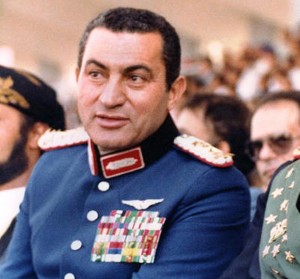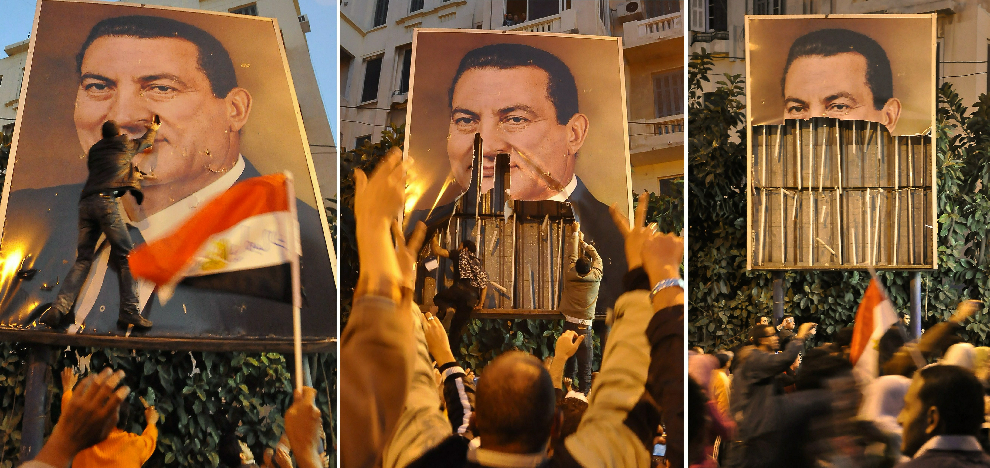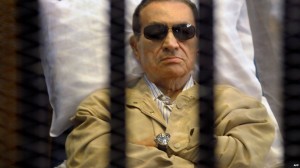
AFP Photo
Mohammed Hosni Mubarak was born on 4 May 1928; He was one of the military leaders who contributed to the 1973 Yom Kippur war.
Mubarak was appointed vice president to Former President Anwar Al-Sadat in 1975 and deputy chairman of the then ruling National Democratic Party (NDP) in 1978.
He came to power on 14 October 1981, through receiving 99.999% of the vote in a referendum after the Peoples’ Assembly nominated him following Sadat’s assassination. He simultaneously became the supreme commander of the armed forces and chairman of the NDP. When he took power, Mubarak announced a state of emergency which lasted during the entire 30 years of his rule.
The 80s: between a comeback to the Arabic political scene and maintaining peace with Israel
During a speech he delivered on 6 October 1981 to announce Sadat’s death, Mubarak stressed the need to stick to all treaties and charters ratified by the state. He added that he would not stop “pushing the wheel of peace forward”, a reference to the newly-enacted peace treaty with Israel.
It was during Mubarak’s first years in power that Sinai was entirely retrieved as Egyptian land. In 1982, Israeli forces exited the whole of Sinai except for the Taba region which Israel claimed as its own. After a struggle in international courts, Taba was retrieved in 1989.
Among Mubarak’s first responsibilities was to restore all that was torn apart during Sadat’s last years in power due to the Camp David accords and the peace treaty with Israel. Egypt’s membership in the Arab League (AL) was frozen for ten years from 1979 to 1989, and the league’s headquarters was moved from Cairo to Tunis. Mubarak worked on Egyptian-Arab relations, creating progress after Sadat’s rift with the Arab states.
On taking power, Mubarak had promised to rule for no more than two presidential term, despite being allowed, according to the constitution, to serve more terms. His first term was renewed in 1987 following a 99.5% majority vote in a referendum.
The 90s: Islamist insurgencies, security solutions, and the birth of privatisation
The 90s held different winds of fortune for Mubarak’s reign. As one of the most violent decades in term of Islamist insurgencies, this phase of Mubarak’s reign witnessed a large number of military trials for civilians, mostly alleged Islamist insurgents believed to be carrying out terrorist attacks nationwide.
The decade witnessed numerous assassination attempts on key authority figures, including Mubarak himself. In 1995, Egyptian assailants shot at the former president’s motorcade while he was visiting Ethiopia. Egyptian officials at the time said extremist Islamist Egyptians travelled to Ethiopia specifically to assassinate Mubarak, in the hope of transforming Egypt into an Islamist state.
It was during the 90s that changes, mostly seen as negative, were made to the Egyptian economy. The government began to implement the ‘privatisation program’ in 1991. Though the program was initially meant to solve Egypt’s economic problems through selling failed state-owned institutions and therefore being relieved of their expenses and making money out of their sale, the conduction of the sale raised several question marks. Economists such as Galal Amin, a professor at the American University in Cairo (AUC), stated that the government sold well-functioning institutions for trifling sums and thus wasted public property and funds.
Egypt’s debts are said to have multiplied during Mubarak’s reign. Standing at $21bn in 1980, one year before Mubarak’s term began, Egypt’s external debt had reached $34.9bn when he was deposed in 2011. Internal debt, it stood at $962.2bn.
The last decade of the twentieth century also witnessed Mubarak’s third term in power, a breach of his promise to serve only two terms. In 1993, another referendum was held on renewing Mubarak’s mandate; naturally, a 99.7% majority voted in favour of him remaining in office. A third referendum was held in 1999, securing Mubarak a fourth consecutive term in power after 99.98% of votes were cast in his favour. Needless to say, the integrity of all such referendums was highly questionable.
The 2000s: the rise of Gamal Mubarak, the proliferation of capitalist NDP figures
Mubarak’s final decade in power was often described as his worst. Rumors spread that the ousted president had withdrawn from political life, leaving the burden of running the state’s affairs to his son, Gamal. It is certainly true that the 2000s saw the rise of Gamal Mubarak on the political scene, coupled with other NDP youth who secured a tight grip on Egypt’s political and economic affairs.
In 2005, Mubarak presented constitutional amendments which would allow for multi-candidate presidential elections to take place in Egypt. Until that time, the president’s term was renewed through a referendum. Should the president fail to reap the majority votes in the referendum, the constitution stated that only then would multi-candidate presidential elections be held. Though a positive move at face-value, opposition movements criticised the amendments as tailored to certain criteria which could only be found in a chosen few candidates, namely Mubarak and his son Gamal.
A referendum on the amendments was held; 86.82% of voters approved them. The passing of the amendments changed the rules; instead of holding yet another referendum to contest granting Mubarak a sixth term in power, he had to compete against nine other presidential candidates. Mubarak won with an 88.571% majority; his most serious contenders were opposition leader Ayman Nour, who gained 7.577% of the vote, and then-head of the Al-Wafd Party No’man Gom’a, who received 2.929% of the vote.
The Ministry of Interior—Mubarak’s Aid:
Mubarak’s Minister of Interior Habib Al-Adly was a cornerstone for the Mubarak regime during his final decade in power. Al-Adly replaced his predecessor Hassan Al-Alfy in 1997 after the latter was sacked following a terrorist attack on Hatshepsut Temple in Luxor that left 58 tourists and four Egyptians dead. Two cabinets were appointed during Al-Adly’s reign, yet he remained in power for 14 years, leaving only with Mubarak’s demise. Coming from the State Security apparatus, Al-Adly’s security background was different from that of his predecessors. This was, allegedly, why Mubarak appointed him.
The longer he stayed, the more savagery was blamed on the entire Ministry of Interior and the more opposition figures accused him of masterminding the repression. It was during Al-Adly’s time in power that videos of detainees brutally tortured in jail began to surface. Amnesty International stated that security authorities during Mubarak’s time enjoyed almost complete immunity from punishment for human rights violations and systematic torture.
Perhaps the most notable torture case was that of Khaled Said, the Alexandria youth who was tortured to death by police officers in 2010. Said’s death is now considered one of the early sparks of the 25 January revolution.
Another catalyst for Mubarak’s fall was the 2010 parliamentary election. Though forgery and vote rigging was commonly used in elections even before Mubarak came to power, everybody was surprised by the extent of forgery Mubarak’s final parliamentary elections witnessed. The NDP asked its members compete for the same seat, thus easily defeating contenders from the opposition. The Muslim Brotherhood, the biggest opposition group at the time, did not win a single seat in the People’s Assembly, whereas Egypt’s biggest opposition party, Al-Wafd, withdrew from the race in protest at the extent of fraud and vote-rigging.
Welcoming the year 2011, Egyptians awaited the possibility of adding a seventh term in power to Mubarak’s rule, or worse, seeing him hand over power to his son Gamal. These fears were alleviated when the protests which broke out 25 January became a revolution.

AFP Photo
Mubarak’s 18-day fight to remain in power
It hit some Egyptians earlier than others that the popular protests which started in late January 2011 would not end before real change was created. Mubarak addressed the nation three times during the 18 days of the 2011 Revolution, in what were perhaps his most watched and most memorable speeches.
The three speeches had one thing in common: they were all late. The speech would come hours after the announcement that the president would address the nation.
The first address to the nation
In his first speech on 28 January 2011, Mubarak announced that he had asked the Cabinet to resign. Ahmed Nazif’s Cabinet would be replaced with Ahmed Shafiq’s, who was Minister of Civil Aviation at the time. His Cabinet was also forced to resign in March by popular demand.
Mubarak also appointed Omar Suleiman as his Vice President, the first vice president in three decades. Suleiman would end up announcing the news of Mubarak’s resignation just a few days later.
“The events of today and the past few days have sparked fear for Egypt and its future in the hearts of the sweeping majority of us,” Mubarak said.
The first speech came on the same day as the Friday of Rage. On that day, police had withdrawn from the streets after violent stand-offs with protesters nationwide. The army was deployed on the streets and for several nights the people had to guard their neighbourhoods assisted by the army.
An emotional appeal in the second speech
In his second speech on 1 February 2011, Mubarak stated that “Hosni Mubarak, who speaks to you today, is proud of the long years he spent serving Egypt and its people. This dear nation… I have lived in, fought for, defended its land, sovereignty, interests, and on its land I will die.”
Not only did these words win Mubarak sympathy, but many people wanted protesters to leave the streets and return to their homes.
Mubarak also announced that he had no intention of running in the presidential elections, which were set to be held in September 2011.
He called on both houses of parliament to amend articles in the constitution that govern the conditions a candidate must meet to run for presidency and the number of terms.
Mubarak offered the people a choice between chaos and stability: “The events of the past few days force us as people and leadership to choose between chaos and stability.”
Some believe that Mubarak could have managed to quell the public rage, after the concessions he made and sympathy he gained. It was what happened the day after that renewed public outrage against the regime: the Battle of the Camel.
The Battle of the Camel refers to violent events that took place on Wednesday 2 February and Thursday 3 February, leaving at least 11 dead and around 1,000 injured. One part of the violence that remains unbelievable even after two years is that dozens of men on horses and camelback charged into Tahrir Square and attacked protesters.
In October 2012, all defendants accused being involved in the “battle” were acquitted.
The drowning man’s last attempt: the third speech
Mubarak made no speeches for over a week. The third speech was the most disappointing to the Egyptian public because it came after much anticipation that Mubarak was set to step down. Chants of “We will not leave, he [Mubarak] has to leave” echoed through Tahrir Square for several days. Protesters were intent on seeing him resign.
Instead of stepping down, Mubarak announced on 10 February that he had handed over his powers to his vice president but he would remain president until the September elections.
He added that he called for amending five articles in the constitution and cancelling one article to ease the conditions needed to run for president, limit the terms of a president, and reinforce judicial oversight to ensure the integrity of elections. He added that cancelling Article 179 opened up the possibility of lifting the state of emergency.
He tried to win public sympathy again, with phrases such as “I have lived for this nation.”
This time, the public was outraged that he had not stepped down.
Stepping down
Mubarak was forced to step down on 11 February after a widespread escalation in protests. The announcement came from his newly appointed Vice President Suleiman.”President Mohamed Hosni Mubarak has decided to give up his post as president of the country and has tasked the Supreme Council of Armed Forces with the administration of the country’s affairs,” Suleiman said in an announcement that lasted a few seconds.
Those words sent jubilant protesters across the country into nationwide celebrations. They had finally managed to force the man who had ruled the country for 30 years to step down.

AFP Photo
After the Revolution
After Mubarak stepped down, the people demanded punishment for the ousted leader and his regime. They accused him of 30 years of corruption and ordering the killing of the protesters during the revolution; on the other hand groups like “I’m sorry Mr. President” and “Mubarak’s sons” launched pages on Facebook to support Mubarak and promote his achievements, the country then went through a series of Mubarak trials, health crisis and rumoured deaths.
Fleeing to Sharm El-Sheikh:
11 February 2011: Vice President Omar Suleiman gave a speech announcing that Mubarak had handed his authority to the Supreme Council of Armed Forces, CBS news broadcasted a video of Mubarak leaving the presidential palace for Sharm El-Sheikh with his family in a presidential helicopter 90 minutes before Suleiman gave his speech.
28 February 2011: The prosecutor general banned Mubarak from leaving the country and announced that the domestic assets of Mubarak and his families would be frozen.
10 April 2011: Mubarak spoke for the first time after his removal in a sound clip broadcast by Al-Arabiya channel. Mubarak expressed willingness to reveal confidential data regarding his bank accounts inside and outside Egypt to clear his reputation after accusations that aim to undermine him and his family.
On the same day Mubarak was summoned by Prosecutor General Abdel Meguid Mahmoud for investigation; he was accused of killing protesters during the 25 January 2011 revolution and of illegal profiteering.
12 April 2011: Mubarak was admitted to Sharm El-Sheikh International Hospital and was investigated at the hospital. The prosecutor general ordered his detention for 15 days pending investigations.
Several official and non-official medical panels headed to Sharm El-Sheikh to investigate Mubarak’s health condition; they had to decide whether it was possible to move the ousted president to Cairo to proceed with investigations.
23 May 2011: Prosecutor General Abdel Meguid Mahmoud issued orders on to refer Mubarak to trial; at the end of the same month a medical committee stated that Mubarak’s medical condition did not allow him to be transferred to Tora Prison Hospital.
Mubarak suffered severe heart palpitations, weak blood circulation to the brain resulting in irregular heartbeat, and was in a severe state of depression, Al-Ahram Weekly reported. Security-wise, it was very difficult to transfer Mubarak to Cairo and thus the committee recommended he stayed at Sharm El-Sheikh International Hospital.
Mubarak between Courtrooms and Hospitals:
3 August 2011: The first session of Mubarak’s trial the defendants included Mubarak, his two sons Gamal and Alaa, Hussein Salem the fugitive businessman and Mubarak’s friend, Mubarak’s Minister of Interior Habib Al-Adly and six of his top aides. The decision came as a surprise to those who never expected the former president would be on trial; foreign politicians and media stated that the trial would be a landmark in Egypt’s history.
A helicopter transferred Mubarak early in the morning to Cairo, where the trial was held at the Police Academy at the Fifth Settlement.
Mubarak appeared in front of the court, headed by Judge Ahmed Refaat, on a truckle bed it was broadcasted live exclusively on Egyptian state television.
Mubarak and his sons denied the charges against them in a courtroom crowded with families of the dead, civil organisations, and civil rights’ lawyers. The trial was postponed to 15 August.
The court also ordered the admission of Mubarak to the InternationalMedicalCenter so that the necessary medical care could be provided for the ousted president.
15 August 2011: The second session of the trial witnessed clashes between protesters in support of and against Mubarak who gathered in front of the Police Academy.
At the end of the session the judge postponed the case till 5 September and ordered an end to the live broadcast of the trials until the verdict session “for the sake of the public interest”, according to Judge Refaat.
5 September 2011: The trial was postponed again to 7 September, then 26 September, then 30 October, and then 28 December amid mounting public discontent with the slow process.
A panel of 10 Kuwaiti lawyers volunteered to defend the ousted president, although some people considered this interference in matters of the Egyptian state.
2 June 2012: The court sentenced Mubarak and his Minister of Interior Habib Al-Adly 25 years in prison for failing to stop killing the protesters; Protesters took the streets in several governorates rejecting the verdict, demanding a re-trial and Mubarak’s execution.
On the verdict Mubarak was admitted to Tora Prison hospital to serve his sentence.
19 June 2012: Mubarak’s health deteriorated and he was transferred to Maadi Military Hospital; rumours about his death circulated in the media but were later denied by the Ministry of Health.
16 July 2012: Prosecutor General Abdel Meguid Mahmoud ordered the transfer of Mubarak back to Tora Prison Hospital after his condition stabilised.
13 January 2013: The Court of Cassation granted Mubarak’s appeal and ordered a retrial for Mubarak and Al-Adly; the decision was received with applause and cheers by Mubarak supporters filling the courtroom. However, Mubarak was not released after the appeal. He remains imprisoned pending investigation in other corruption cases.



